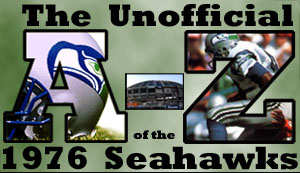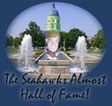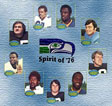
No longer a child, not yet middle-aged, and still finding their place in the NFL world.
...the 30-year wall of silence is an impressive achievement for a League that leaks as a lifestyle.
He recommended Jack Patera enthusiastically for the Seahawks...
The letter C is coming soon!
The Seahawks used Williams’ local reputation as a promotional tool, as they would do (very briefly) with Ahmad Rashad.
The average Seahawk selected in the veteran allocation is 6-2, 222 pounds, just under 26 years old and is entering his fourth NFL season.
The Seahawks played the Rams...facing off against future Seahawk coaches Chuck Knox, Tom Catlin and Ken Meyer.
...management decided early to pursue coaches with no NFL head coaching experience.
Patera had the boldness to recruit 3 coaches with no NFL service...
...why was there no place for one of the ultimate local heroes of the early 1970s – Sonny Sixkiller?
Thompson may have looked on paper like a conservative and safe manager for a new team with first-time owners, but...
...reports from the camp are unclear as to who did the special team evaluations.
As a defensive coach, Jack Patera valued his linebackers.
Maybe we'll come up with something soon!
...nobody else on the Seahawks squad took their dislike quite to the extent of Ahmad Rashad.
The Nordstroms were an obvious possibility because of their wealth and local presence.
Approximately 14 members of that squad would never play for the Seahawks again.
A simple lesson in draft history is to list the fate of quarterbacks for several years before 1976.
Jack Patera was unable to take a single Redskin veteran from the allocation list.
...the Seahawks’ offense would be directed by 3 men who had 2 years of NFL experience between them
Terry Brown’s Seahawk career lasted less than 24 hours.
...we think this story might just have been a good Patera Prank!
While Patera had an inside edge on stocking his team with Vikings, he only chose one Viking from the allocation...
Character would clearly play a part...
Patera lived up to his code of we will tolerate you until we can replace you...
Yes! We will have something for Y eventually!
What more need we say?
|
Intro |
A |
B |
C |
D |
E |
F |
G |
H |
I |
J |
K |
L |
M |
N |
O |
P |
Q |
R |
S |
T |
U |
V |
W |
X |
Y |
Z |
Home

D is for Dave Williams
Dave Williams’ story is one of the what-ifs of 1976. He was attractive enough to be the only player signed before Jack Patera was appointed, and prominent enough to be the first public face of the Seahawks, but one basketball game derailed his career. He had been a local star, playing high school football in Tacoma and college football at the University of Washington. His NFL career had taken him to St Louis (1967-71), San Diego (1972-73) and Pittsburgh (1973) before he jumped to the short-lived World Football League. The Seahawks signed him as a free agent in November 1975 from the Southern California Sun. By one of those coincidences of football, Williams would be reunited in Seattle with his 1971 St Louis coach, Bob Hollway. Williams was one of the few genuine free agents from the WFL, having been released by the Steelers in 1973 before crossing to the NFL. WFL players who had broken their NFL contracts were bound to their previous NFL team (see Allocation), but Williams was free to negotiate with the Seahawks as well as several other teams. The Seahawks used Williams’ local reputation as a promotional tool, as they would do (very briefly) with Ahmad Rashad. His endorsement career also took off, with a number of local businesses eager to trade on his name. And he took to his promotional role with enthusiasm. Without a coach and a playbook there wasn’t much else for him to do in the city for the next few months, but Williams’ commitment to creating interest in the Seahawks can’t be faulted. By contrast with Rashad’s brief stay as a Seattle celebrity, Williams worked hard for his new team. Although Williams had a local profile, well-known football skills and plenty of experience, John Thompson’s decision to sign him was still a daring one. It’s not clear even now how Thompson saw him fitting into the new team structure: signing him well before a coach had been selected, and promoting him with such intensity, would have created a problem if he and the coach didn’t work well together. And (with no insult meant) his career had probably seen its best days. At 30, and after 9 seasons, Williams was no longer producing the dominant statistics of his Washington and St Louis days. He never repeated his spectacular 1969 season (56 completions, 702 yards/12.5 yards average, 7 touchdowns), although it has to be said that Harland Svare’s 1972–73 Chargers was no place for any receiver to shine. When Svare stepped down after a 1-6-1 start in 1973, Pittsburgh, the WFL and even Seattle would have seemed like paradise. Unfortunately, he never gave history the chance to find out what he could have done. He suffered a serious knee injury in a publicity-stunt basketball game and was released on 20 August 1976 — making way for Steve Largent.
|


